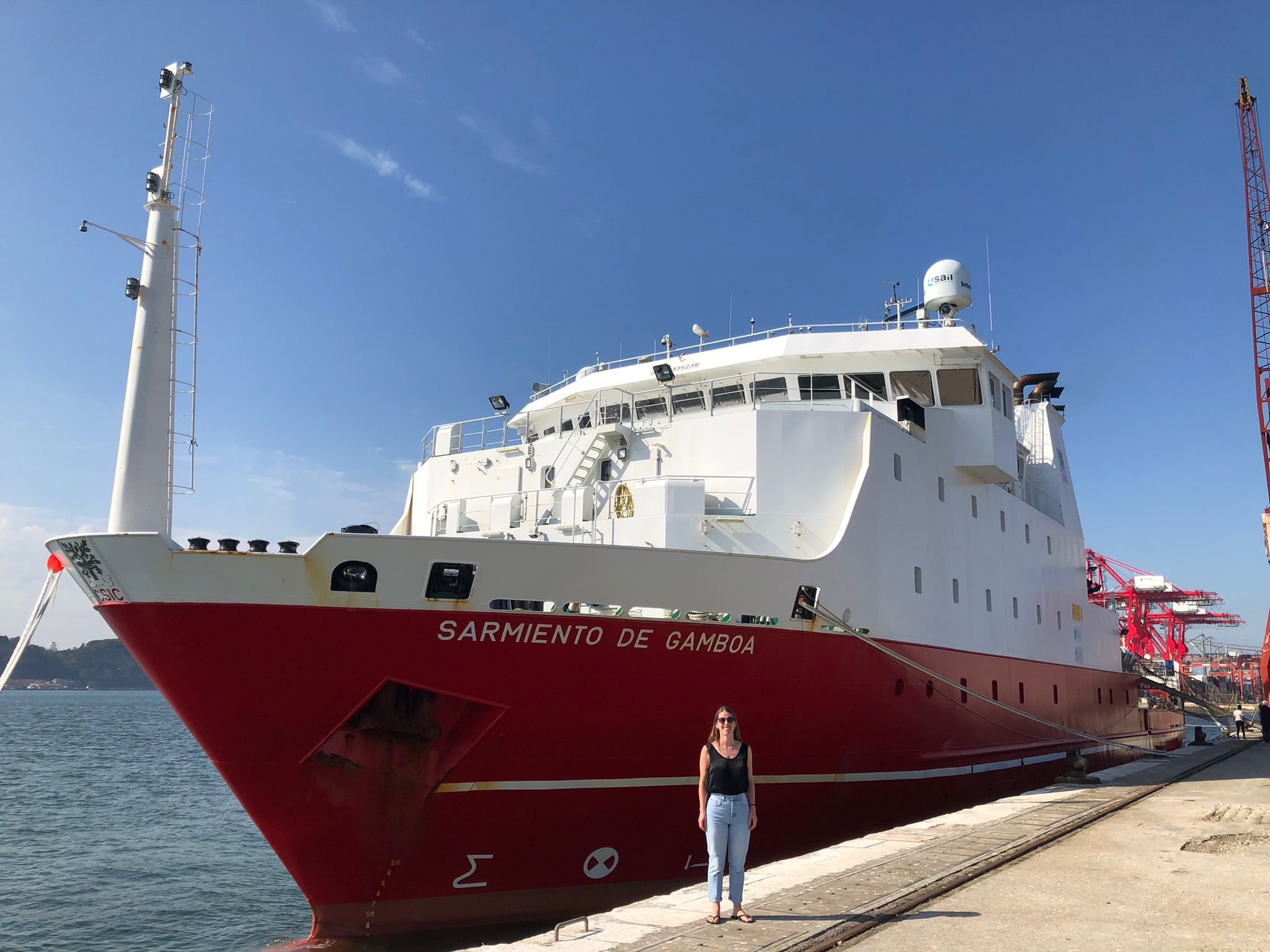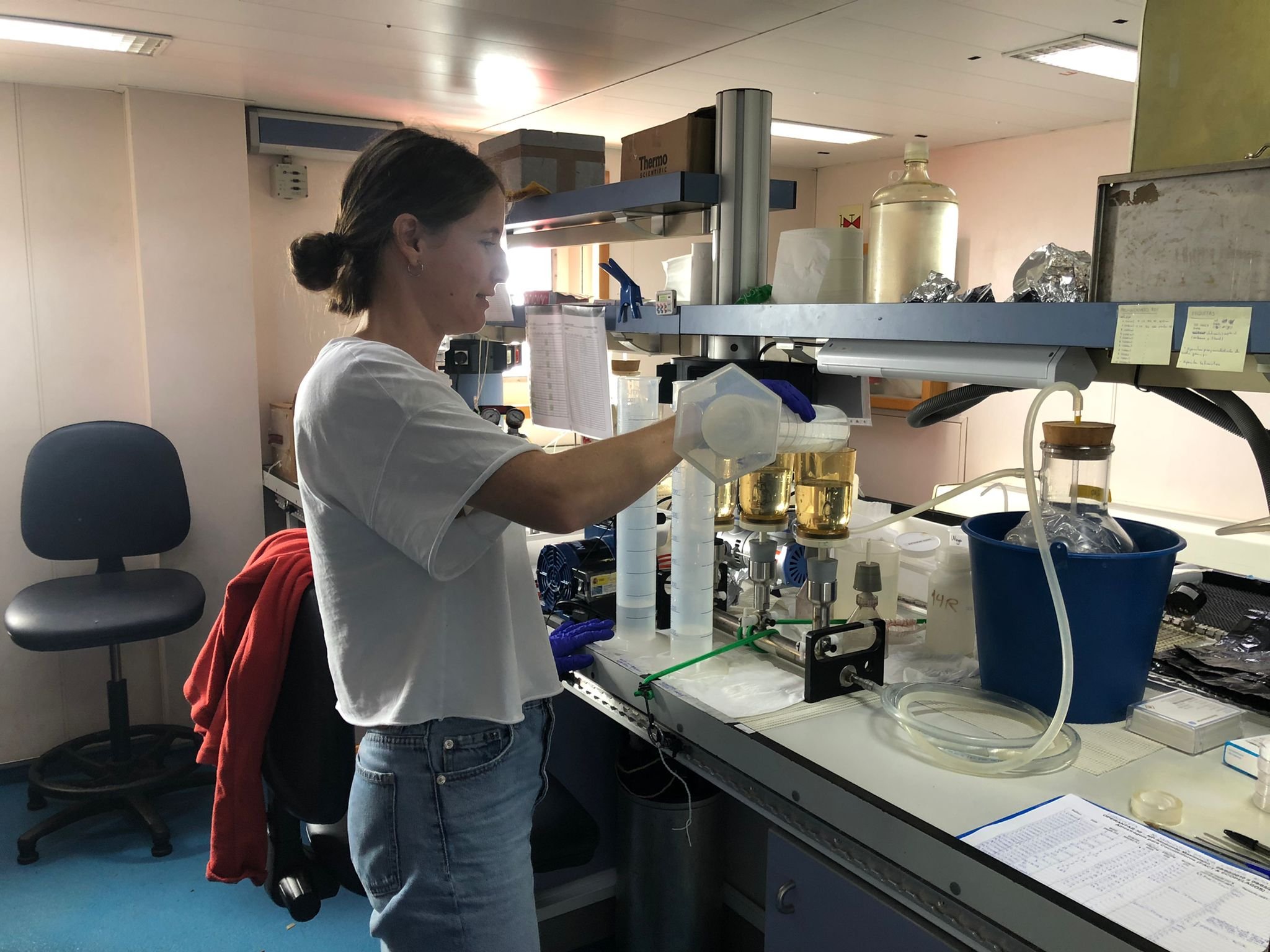Despite of being some of the most productive ecosystems in the global ocean, oceanic fronts marked by intensified exchanges between coastal upwelling waters and the open ocean are still poorly understood. To contribute to fill this gap, the team from CHASE/PRIMUS-related project SINES (Climate Change Impact on Ocean Fronts Ecosystems: the case of the Iberian Upwelling System) was recently on board of RV Sarmiento de Gamboa (10-20 September 2022) to collect high-resolution data from a broad range of environmental parameters across an upwelling front offshore the SW coast of Portugal. SINES is led by Marcos Fontela and Fátima Abrantes from CCMAR/IPMA and includes a team of marine researchers from 18 different research laboratories (6 EU countries), aimed at using the in-situ collected parameters in biogeochemical models exploring the present and past ocean conditions in the context of climate change, including the effects of ocean acidification, thermal stratification, and deoxygenation. The cooperation of all involved partners will provide novel and fundamental calibration proxies to produce a baseline for the identification, quantification, and validation of modern ecosystem changes with respect to pre-industrial status.
The project SINES team on board of RV Sarmiento de Gamboa.
While coccolithophores are not as responsive to nutrient enrichment as, for example, diatoms, they still form a major component of the oceanic phytoplankton and are one of the main open-ocean primary producers. Certain species of more opportunistic behaviour can produce some massive blooms at the surface of the ocean, than are optically reflective enough to be seen from space! In fact, such species (Emiliania huxleyi, Gephyrocapsa oceanica) were seen to quickly respond to transient optimum nutrient-light-buoyancy conditions provided by late winter river runoff and upwelling offshore central Portugal! Shortly after rapid exhaustion of silica by diatoms, coccolithophores were seen profiting from nitrates and phosphorus still available at the surface, showing their ability to take advantage of intermittent nutrient replenishment. This highlights the importance of considering short-term variability when investigating the ecology dynamics of coccolithophore communities in the context of highly dynamic and transient coastal settings [Guerreiro et al., 2013; Guerreiro et al., 2014].
LANDSAT Satellite image of Emiliania huxleyi bloom in the English Channel off the coast of Plymouth (Cornwall) 24, July 1999 (Photo: NASA, image courtesy of Andrew Wilson and Steve Groom).
In addition, because their cells’ surfaces are covered by minute external calcite scales - the coccoliths -, coccolithophores represent the single most important component of deep-sea sediments, providing floral and biomarker signals for interpreting global change in the geological record. Indeed, their original ecological gradients found across the coastal-neritic-oceanic transition observed in the central Portuguese Margin revealed a good correspondence with the patterns of coccoliths in the underlying sediment [Guerreiro et al., 2015a]. Despite of losses in species diversity of the living original coccolithophore assemblage because of taphonomical effects [Guerreiro et al., 2015b], this testifies on the great potential of coccoliths as a tool to investigate environmental variability both in the present and in the past, even in highly dynamic regions such upwelling-related oceanic fronts.
The figure above illustrates the main factors that affect the coccolithophore assemblage from the moment of its production (biocoenosis) in the oceanic photic layer until its burial in the underlying sediment (thanatocoenosis ≥ taphocoenosis ≥ orictocoenosis). P = productivity resulting from coccolithophore blooms, N = necrolysis mediated by zooplankton grazing, B = rapid vertical transfer of coccospheres within faecal pellets produced by zooplankton, PE = strong ecological signal, SAR = sediment accumulation rate, and D = diagenetic phenomena (e.g., dissolution, recrystallization). The conical shape is meant to schematically represent the area of production (P) and transport (B) from which a coccolith assemblage preserved in a seafloor sediment sample may be derived [Guerreiro et al., 2015b].
In the context of the SINES project, we are interested in using coccolithophore (paleo)ecological data as indicators of ocean primary production and biogeochemical processes associated to ocean front ecological dynamics in the western Iberia. To that aim, young researcher Mara Gomes (MARE/FC.ID) was onboard of the ship to collect samples for the study of the concentrations of coccospheres (cells) and coccoliths produced by coccolithophore species along the photic zone, and its subsequent (paleo)ecological record preserved in seafloor sediments. Mara is currently funded under the scope of CHASE-affiliated ESA-project PRIMUS and she will actively participate in this study. The coccolithophore data will be further analysed in relation to the entire phytoplankton community (inferred from photosynthetic pigments) and with hydrographic and meteorological parameters measured during the seawater sampling.
Mara Gomes in front of R/V Sarmiento de Gamboa, a multidisciplinary oceanographic research vessel managed by the Marine Technology Unit (UTM) of the CSIC (Vigo-based) which is fully equipped to study all processes related to ocean circulation, including biodiversity and fishery resources.
The filtered material for coccolithophores will be analysed using a polarizing light microscope, from which the species composition and abundance will be determined by identification and counting on measured filter transects. The study will be undertaken within a multi-parameter approach, considering the hydrographic and meteorological conditions (i.e., temperature, salinity, fluorometry, turbidity, nutrients, PAR, wind) during the cruise, and further compared with the coccolith assemblages obtained from the sediment records. Insights gained from this study will ultimately contribute to calibrate the ecological preferences of coccolithophores and their potential as (paleo)environmental proxies for the Iberian Continental Margin.
This collaboration will provide a remarkable opportunity to compare the living coccolithophore communities with their sub-fossil record preserved in the underlying sediments, but also with other important functional phytoplankton groups (e.g., dinoflagellates, diatoms) as well as other planktonic calcifying organisms (e.g., foraminifera) and biomarkers (e.g., alkenones) which will be studied by our SINES scientific partners.
Results will also contribute to build on work dealing with net primary production (NPP) processes in the Iberian upwelling system which we are working on in the context of project PRIMUS (e.g., Science Case 3 – Lagrangian estimation of NPP in upwelling systems; Science Case 6 – Eutrophication in the Iberian upwelling system; Science Case 7 – Relationship between NPP and fisheries in the Iberian upwelling system).
Stay tuned for all the interesting results yet to come! :)
Sub-sampling of seawater from the Niskin bottles of the CTD-rosette sampler (above) and its sub-sequence filtering for the study of coccolithophore communities and of photosynthetic phytoplankton pigments (below). A total of 68 coccolithophore samples were collected at 5 m, 25 m, 50 m, 75/100 m and bottom nepheloid layer (BNL) from 15 stations along a coast-to-ocean transect off Sines and in the Portuguese south coast. For the pigment analysis, a total of 30 samples were additionally collected at 5 m water depth, and from the Deep Chlorophyll Maximum (DCM).





